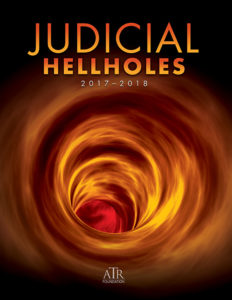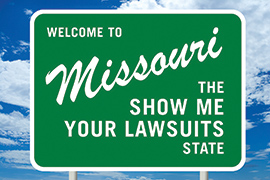High Court’s Contempt for Lawmakers’ Authority, Lawsuit Rackets Place Florida atop Latest ‘Judicial Hellholes’ List
Annual Report Also Sharply Critical of Civil Courts in California, St. Louis,
New York City, Philadelphia, New Jersey, Illinois and Louisiana
♦
State Courts in Georgia, Maryland, Oregon, Pennsylvania, Virginia
and West Virginia Make the ‘Watch List,’
Along with U.S. Court of Appeals for the Ninth Circuit
♦
‘Points of Light’ Focus on Attorneys General Cracking down on Fraudulent ‘ADA’ Lawsuits,
17 Tort Reforms In 13 States, and Sound Court Decisions in Oregon,
the Fifth and Seventh Circuits, and ‘Xarelto’ MDL
♦
Three ‘Closer Looks’ Examine U.S. Supreme Court’s Jurisdictional Decisions’ Impact on Forum-Shopping and Trial Lawyers’ Influence on Both Opioid Litigation
and the American Law Institute
WASHINGTON, D.C., December 5, 2017 – The American Tort Reform Foundation issued its 2017-2018 Judicial Hellholes® report today, naming courts in Florida, California, Missouri, New York, Pennsylvania, New Jersey, Illinois and Louisiana among the nation’s “most unfair” in their handling of civil litigation.
 “With both this annual report and a year-round website, our Judicial Hellholes program since 2002 has been documenting troubling developments in jurisdictions where civil court judges systematically apply laws and court procedures in an unfair and unbalanced manner, generally to the disadvantage of defendants,” began American Tort Reform Association president Tiger Joyce.
“With both this annual report and a year-round website, our Judicial Hellholes program since 2002 has been documenting troubling developments in jurisdictions where civil court judges systematically apply laws and court procedures in an unfair and unbalanced manner, generally to the disadvantage of defendants,” began American Tort Reform Association president Tiger Joyce.
“This year, thanks to a state high court majority’s barely contained contempt for the policy-making authority of the legislative and executive branches of government, and a notoriously aggressive and sometimes lawless plaintiffs’ bar, Florida earns the ignominious #1 ranking among eight Judicial Hellholes, even as authorities have begun to crack down on some of the lawsuit industry’s most obviously fraudulent rackets.
“Ranked #2 is perennial hellhole California, where lawmakers, prosecutors and plaintiff-friendly judges inexorably expand civil liability at the expense of businesses, jobseekers and those desperately in need of affordable housing,” Joyce explained. “The good news is the U.S. Supreme Court in June reversed a California high court decision that we criticized in last year’s report. Had it been allowed to stand, California’s courthouse doors would have been thrown open even wider to out-of- state plaintiffs suing out-of- state defendants over alleged out-of- state injuries.
 “The City of St. Louis Circuit Court, last year’s #1 Judicial Hellhole, drops to #3 this year by virtue of a change in gubernatorial leadership, a good start by state lawmakers on an agenda of much needed civil justice reforms and that same U.S. Supreme Court decision curbing forum shopping in California. It should do the same in the ‘Show Me Your Lawsuits State.’
“The City of St. Louis Circuit Court, last year’s #1 Judicial Hellhole, drops to #3 this year by virtue of a change in gubernatorial leadership, a good start by state lawmakers on an agenda of much needed civil justice reforms and that same U.S. Supreme Court decision curbing forum shopping in California. It should do the same in the ‘Show Me Your Lawsuits State.’
“If only comparable progress could have been made in New York City’s
Asbestos Litigation (NYCAL) court, ranked #4 this year. A much anticipated update to the court’s Case Management Order proved to be a great disappointment for defendants, as the plaintiff-favoring judge who wrote it was predictably rewarded with an appellate court appointment by a governor who acknowledges that trial lawyers are ‘the single most powerful political force’ in the state.
“Next on this year’s list comes Philadelphia, which had in the fairly recent past managed to reform its Court of Common Pleas’ Complex Litigation Center. Out-of- state mass tort filings had steadily ticked down in the past few years, but such claims are surging again, along with multimillion-dollar verdicts. So a return to the ranks of Judicial Hellholes at #5 is appropriate for the ‘City of Unbrotherly Torts.’
“It’s a similar story in #6 New Jersey, where bad high court decisions had encouraged meritless consumer litigation and undermined arbitration agreements in seemingly lawful contracts, while a lax standard for expert testimony continues to attract many products liability plaintiffs from across the country. To the state high court’s credit, however, it issued a 2017 decision that should discourage the more outrageous consumer class actions that in recent years had choked Garden State courts like weeds.
“Illinois’ Madison County and Cook County collectively comprise the #7 Judicial Hellhole this year,” Joyce continued. “They both attract disproportionate volumes of litigation and produce large verdicts. Mostly rural Madison County remains the nation’s epicenter for asbestos litigation as plaintiff-friendly judges still dominate. And since most local and state politicians seem comfortably in cahoots with the powerful plaintiffs’ bar, prospects for reforms remain remote, even as these jurisdictions’ hyper-litigiousness works against economic growth and job creation.
“Rounding out the latest Hellholes list is #8 Louisiana,” Joyce reported, “where a former trial lawyer turned governor cheerleads litigation against the Pelican State’s critical energy industry and has hired rich political donors to run it. Ethically challenged judges and seemingly bogus ADA lawsuits make things worse.”
Joyce said jurisdictions on the report’s marginally less severe “Watch List” this year include state courts in Georgia, Maryland, Oregon, Pennsylvania, Virginia and West Virginia, along with the U.S. Court of Appeals for the Ninth Circuit.
The report’s “Dishonorable Mentions” include singularly unsound decisions by Connecticut’s high court ($42 million for an unforeseeable tick bite) and a Wisconsin appellate court (striking down a limit on medical liability), as well as three tort reform vetoes by Minnesota Gov. Mark Dayton, “a plaintiffs’ bar puppet.”
“But also eager to emphasize good news,” Joyce noted, “our report’s “Points of Light” section this year spotlights actions taken by attorneys general in Arizona, New Mexico and Nevada, cracking down on often fraudulent disability-access lawsuits that target small businesses. Several sound state and federal court decisions and verdicts are also applauded, as are 17 positive tort reforms enacted in 13 states in 2017.
“Finally, this year’s three ‘Closer Looks’ examine the U.S. Supreme Court’s jurisdictional decisions in 2017 and their likely impact on forum-shopping, as well as trial lawyers’ growing influence on fast-spreading opioid litigation and the long-respected but suddenly changing American Law Institute,” Joyce concluded.
Read the Executive Summary or the full text of the 2017/2018 Judicial Hellholes report.






